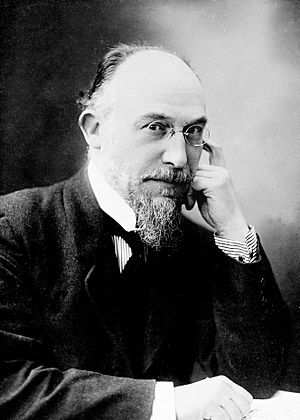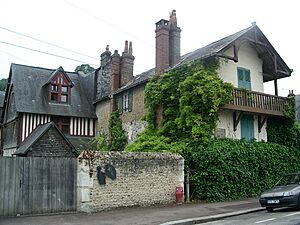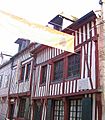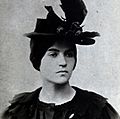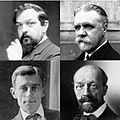Erik Satie facts for kids
Erik Satie (born in Honfleur, France, on 17 May 1866; died in Paris, 1 July 1925) was a French composer. He is remembered today for his unique personality and his interesting music. He often gave his pieces unusual names, like Piece in the form of a pear.
His most famous works are three piano pieces called Gymnopédies. The first Gymnopédie is a very well-known and simple tune with a gentle background music. Satie sometimes used surprising instruments in his music, such as sirens and typewriters.
Satie was more than just an unusual person. He played a very important role in how music developed in France during the late 19th and early 20th century. His new ideas influenced many other musicians. Satie explored ways of composing, like using very simple, repeated musical ideas (which later became known as Minimalism), before many others did. These styles became more common later on. Satie enjoyed creating music that was simple yet beautiful. He was also interested in other art forms, such as literature and painting. He was connected to new artistic ideas called esprit nouveau (new spirit), which were popular in France around the time of World War I.
Contents
His Life
Early Years and Education
He was born Alfred Eric Leslie Satie, but as an adult, he always spelled his name “Erik”. His father worked in the shipping business. The family later moved to Paris. When Satie was quite young, his mother died. He was sent back to his birthplace, Honfleur, to live with his father’s parents.
However, his grandmother passed away, so he returned to Paris. His father had remarried, and his new wife was a pianist. She encouraged young Erik to take piano lessons at the Paris Conservatoire.
Satie did not enjoy his piano lessons. His teacher even said he was the laziest student there. He struggled with sight-reading music. He continued his lessons because it would allow him to do only one year of military service instead of five. In the end, he served less than a year in the army because he purposely made himself ill with bronchitis. While recovering, he began to compose music. His father published a few songs he had written. However, Satie did not get along well with his family and left home in 1887.
The Young Composer
Satie soon met many people at the famous cabaret Chat Noir. He grew his hair long and wore a frock coat and a top hat. He wrote a ballet that many found quite shocking. He became friends with Debussy, who was one of the few people who understood the serious reasons behind Satie’s unusual behavior.
In 1890, he moved to a top-floor room in a house to avoid people he owed money to. He tried to compose in a simple style and became interested in mystical religion and Gothic art. He received a small amount of money and used it to buy seven identical velvet suits, one for each day of the week. He even started a church called Église Métropolitaine d’Art de Jésus Conducteur (Metropolitan Church of Art of Conductor Jesus), but he was its only member.
At the end of 1898, he moved to Arcueil, a suburb of Paris, where he lived for the rest of his life. He stopped performing in public and earned money by playing the piano in cafés and pubs. Every morning, he walked 10 kilometers into Paris, stopping at cafés along the way to drink or compose. He wore a bowler hat, a wing collar, and always carried a rolled-up umbrella. If it was raining, he kept his umbrella under his coat to keep it dry. He also carried a hammer for protection. Late at night, he would walk home or take the last train. His flat was known to be very messy.
Rise to Fame
In 1905, at the age of 39, Satie decided to become a student again. He studied music at the Schola Cantorum to improve his composing skills. He learned how to write fugues, a type of musical composition. He still enjoyed using parody and humor in his music.
In 1911, Maurice Ravel played some of Satie’s piano pieces in public. Suddenly, people started to notice Satie. They realized he had been one of the first Impressionist composers. Debussy conducted Satie's Gymnopédies in an arrangement for orchestra. Music critics began writing articles about Satie, and he was finally becoming famous. He had some funny piano pieces published and started earning money from his compositions, which meant he could stop playing in cabarets.
He met Jean Cocteau, who introduced him to Diaghilev. Satie wrote the music for Diaghilev's ballet Parade. Some people loved it, while others disliked it, but everyone was talking about it. He was asked to write more music for the theater. Satie was a very important influence on a group of six composers known as Les Six. He was also asked to write a symphonic drama, which he called Socrate. Many musicians consider this his best work.
Final Years
In the 1920s, Satie wrote many articles for newspapers and journals. He became connected with the art movement called Dada. His ballets Relâche and Mercure both surprised audiences when they were first performed. Relâche is an early example of a style that later became known as the theater of alienation.
Satie became ill and passed away in 1925. After he died, his friends entered his flat and found it so messy that they had to remove two cartloads of rubbish before they could find his papers and manuscripts.
His Music
Satie was involved with dance, theatre, and cabaret for most of his life, and much of his music was written for these art forms. He was always trying out new ideas in his music. He could write in a late Romantic style with complex harmonies, but he also wrote in more modern styles, often using very simple ideas. He was always more interested in beautiful melodies than in writing complicated rhythms.
His three Gymnopédies are still extremely popular. They sound like they come from an older, simpler world. His three Gnossiennes (1890) have a more Oriental sound, and Satie wrote some very strange notes in the music. His piano piece Vexations (1893) is a short piece with unusual, complex chords, which the pianist is supposed to play 840 times. Uspud was an early example of what later became the “Theatre of the Absurd”. The text for Uspud was written entirely in lower-case letters, which was a first at the time. He also wrote many cabaret songs.
Later, after studying at the Schola Cantorum, Satie became famous. He then wrote many piano pieces with funny titles and strange comments (for example, “like a nightingale with toothache”). Parade includes unusual instruments like typewriters. Socrate was his most serious work.
After his death, some people who Satie had upset wrote negative things about his music. Because of this, he was almost forgotten until the 1960s, when John Cage became interested in his music and helped make it popular again. Many Surrealist artists were often inspired by Satie’s music and ideas.
Images for kids
-
Satie's birthplace and childhood home, now a museum in Honfleur, Normandy
-
Satie by Santiago Rusiñol, 1891
-
Suzanne Valadon, 1885
-
Satie's final persona, bowler-hatted and formally dressed
-
Parade, 1917 – music by Satie, décor by Picasso
See also
 In Spanish: Erik Satie para niños
In Spanish: Erik Satie para niños


